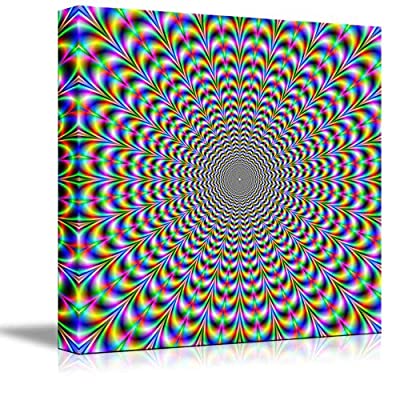“Didn’t I just see….?” “Wait, wasn’t that a…?” “What’s going on here!” All of these questions and exclamations are exactly what people say after seeing an optical illusion? Have you ever seen one, either on the internet, a museum or in a book? If you haven’t here’s a run down on what they are. Optical illusions are a type of illusion that tricks the human eye into seeing something that doesn’t quite match with our usual visual perceptions. There are three different classes of optical illusions: physical, physiological and cognitive illusions. In each of these classes, there are four kinds of illusions: ambiguities, distortions, paradoxes and fictions. Each of these types if illusions throws off our senses, and makes us see things that we think we shouldn’t be seeing. Are you interested in learning more? Read below for more optical illusion wall art facts.
Brain & Eye

The word “optical” in the phrase ‘optical illusions’, is meant to denote that it’s a type of illusion that we see. Although it is technically true that we see optical illusions, it’s important to make an important distinction. Optical illusions, first and foremost, occur in the brain! According to researchers, visual illusions are mostly caused by the properties of the visual areas of our brains. The way our brains receive, store, and process visual information is a huge part of why what we see with out eyes can throw us off. That said, not all optical illusions occur in the brain. A common optical illusion doesn’t come from a piece of art, but from something we do to our bodies? Have you ever been hit so hard that you “see stars?” Seeing stars is a natural optical illusion that occurs due to the mechanical stimulation and activation of the neurons in the eye. Read below for more optical illusion wall art facts.
History
It’s always been fun to mess around with human perception. So fun, in fact, that it’s been done since the time of the ancient Greeks! In fact, Aristotle was recorded as noticing that watching a waterfall and then shifting your attention to static rocks makes the rocks appear to move in the opposite direction of the flow of the waterfall. His discovery became known as the “motion aftereffect.” Did you know that the word “illusion” comes from the Latin language? The root of illusion comes from the Latin word “illudere,” which means “to mock.” The word illusion was first created sometime during the days of where the Gauls roamed in ancient France.
Sleep
Did you know that illusions can be caused by natural physical states? We’ve already established that getting hit can cause a person to “see stars,” but simply living a regular life can also produce a similar effect. Insomnia, which is a form of sleep deprivation, can cause us to see optical illusions. If you didn’t know before, the lack of sleep can cause a plethora of ailments including: fatigue, hallucinations, and the inability to concentrate. Sleep deprivation causes optical illusions that can ebb and flow over the course of a day. Our advice? If you want to avoid unprompted illusions, make sure you get your rest!
Types

As previously stated, optical illusions come in different types. A literal optical illusion occurs when the image you see is different from the images that make it up. For example, two images drawn to look like one fluid image would be a good example of a literal optical illusion. Physiological optical illusions rely on the stimulation of the brain’s senses. When the eye views an extremely dynamic illusion, the brain has trouble processing things like color, dimension, size and movement. A common type of physiological illusion would be the stereotypical hypnotizing, swirling black and white spiral that most people are familiar with. Did you enjoy reading these optical illusion wall art facts?
Conclusion
So now that you know a little bit more about them, how do you feel about optical illusions? Do you find them interesting in how they trick both the brain and the eyes? Or maybe you find them annoying? You may even be a person who feels nauseous looking at them. However you feel about these illusions, we hope you enjoyed reading these optical illusion wall art facts.



